Iowa class battleship
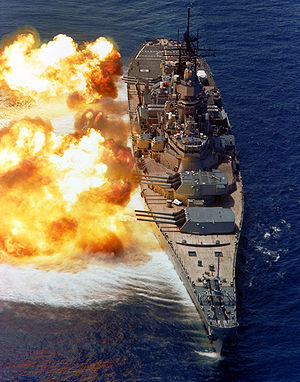 USS Iowa (BB-61) fires a full broadside on 15 August 1984 during a firepower demonstration after her recommissioning. |
|
| Class overview | |
|---|---|
| Name: | Iowa class battleship |
| Builders: | New York Naval Shipyard (BB-61 & BB-63) Philadelphia Naval Shipyard (BB-62, BB-64, & BB-65) Norfolk Naval Shipyard (BB-66) |
| Operators: | |
| Preceded by: | South Dakota class battleship |
| Succeeded by: | Montana class battleship |
| In commission: | 1943–1992 |
| Planned: | 6 |
| Completed: | 4 |
| Cancelled: | 2 |
| Retired: | 4 |
| Preserved: | 4 |
| General characteristics | |
| Type: | Battleship |
| Displacement: | 45,000 tons (Standard); 52,000 tons (mean war service); 58,000 tons (full load)[1] |
| Length: | 861¼ ft (262.5 m) between perpendiculars 890 ft (271 m) overall[2] |
| Beam: | 108 ft (33 m)[1] |
| Draft: | 36 ft (11 m) maximum[2] |
| Installed power: | 212,000 shp (158,000 kW)[1] |
| Propulsion: | 4 screws;[1] General Electric geared turbines;[1] 8 Babcock & Wilcox Boilers; G.E. (BB-61;BB-63); West. (BB-62; BB-64; BB-66)[1] |
| Speed: | 31 knots (57 km/h) normal operating[3] 35 knots (65 km/h) theoretical maximum (light displacement)[3] |
| Range: | 14,890 miles (23,960 km) @ 15 knots (28 km/h)[2]; 11,700 miles (18,820 km) @ 20 knots (37 km/h) [2] |
| Complement: | |
| Electronic warfare and decoys: |
|
| Armament: |
|
| Armor: | Belt: 12.1 in (310 mm),[5] Bulkheads: 11.3 in (290 mm),[5] Barbettes: 11.6 to 17.3 in (295 to 439 mm),[5] Turrets: 19.7 in (500 mm),[5] Decks: 7.5 in (190 mm)[5] |
| Aircraft carried: |
|
| Notes: | Final battleship class completed by the United States |
The Iowa class battleships are a class of six fast battleships of the United States Navy ordered in 1939 and 1940 to escort the Fast Carrier Task Forces, which operated in the Pacific Theater of World War II. Four were completed in the early- to mid-1940s; two more were laid down, but they were canceled prior to completion and eventually scrapped. The last U.S. battleships to be built, all four are either on display as museum ships or are mothballed as of May 2010.
Iowa-class battleships served in every major U.S. war from World War II to the Gulf War in 1991. In World War II, they defended aircraft carriers and shelled Japanese positions before being placed in reserve at the end of the war. Recalled for action during the Korean War, the battleships provided artillery support for UN forces against North Korea. In 1968, New Jersey was recalled for action in the Vietnam War and shelled communist targets near the Vietnamese Demilitarized Zone. All four were reactivated and armed with missiles during the 1980s as part of the 600-ship Navy. In 1991, Missouri and Wisconsin fired missiles and 16-inch (406 mm) guns at Iraqi targets during the Gulf War. All four battleships were decommissioned in the early 1990s as the Cold War ended, and they were initially removed from the Naval Vessel Register; however, at the insistence of the United States Congress, two were reinstated to the Naval Vessel Register for maintenance in the mothball fleet of 1995. These last two battleships were removed from the Naval Vessel Register in 2006.
Contents |
Design
Background
After the end of the First World War, many navies, including those of the United States, the United Kingdom, and Imperial Japan, continued and expanded construction programs that had begun during the conflict. The enormous costs associated with these programs pressured government leaders to begin a disarmament conference. On 8 July 1921, the United States' Secretary of State Charles Evans Hughes invited delegations from the major maritime powers—France, Italy, Japan, and the United Kingdom—to come together in Washington, D.C. and discuss a possible end to the naval arms race. The subsequent Washington Naval Conference resulted in the Washington Naval Treaty, which, among other provisions, limited all future battleships to a standard displacement of 35,000 long tons (36,000 t) and a maximum gun caliber of 16 inches (406 mm). It was also agreed that the five countries would not build new capital ships for ten years and would not replace any ships that survived the treaty until the ships were at least twenty years old.[7][8]
Further limitations were required by the (first) London Naval Treaty of 1930, but Japan, perceiving the Washington treaty to be punitive, announced in 1934 that it was entirely withdrawing from the treaty system. A second conference in London in 1935 was unable to reach an agreement with Japan; in response, France, the United Kingdom, and the United States adopted a different approach in the Second London Naval Treaty of 1936, which reaffirmed many of the requirements of the Washington treaty and even lowered the maximum gun size to 14 inches (356 mm), on condition that Japan should also respect these limitations.[9] The new treaty heavily influenced the design of the predecessors of the Iowa class, the North Carolina, and South Dakota classes.[10][11]
In November 1937, intelligence agencies heard rumors of Japanese "super-battleships", though the specifications of these ships varied by source of information. As evidence of these new Japanese ships grew, the United States, United Kingdom, and France all approved a new maximum tonnage limit of 45,000 long tons (46,000 t) on 31 March 1938, allowing the Iowa-class ships to weigh 45,000 long tons (46,000 t).[12]
27-knot battleships and "A"–"C"
After these political developments, the Navy was able to continue with 45,000 long ton design studies. Work began on the first study in early 1938 at the direction of Admiral Thomas C. Hart, head of the General Board. It was an expanded South Dakota carrying either twelve 16-inch/45 caliber Mark 6 guns or nine 18-inch (460 mm) guns (the latter armament being dropped after the 31 March agreement), with more armor and a power plant powerful enough to drive the larger ship through the water at the same speed as the South Dakotas, 27 knots (31 mph; 50 km/h).[13] These studies had no further impact on the design of the Iowa class, but development of this design continued and eventually evolved into the design for the Montana class.[14]
Another design, pursued by the Design Division section of the Bureau of Construction and Repair, was a "cruiser-killer." Beginning on 17 January 1938 under Captain A.J. Chantry, the group drew up plans for ships with twelve 16-inch and twenty 5-inch guns, Panamax capability but otherwise unlimited displacement, a top speed of 35 knots (40 mph; 65 km/h), and a range of 20,000 nautical miles (23,000 mi; 37,000 km) when traveling at the more economical speed of 15 knots (17 mph; 28 km/h). Their plan fulfilled these requirements with a ship of 50,940 long tons (51,760 t), but Chantry believed that more could be done if the ship were to be this large; with a displacement greater than that of most battleships, its armor would only have protected it against the 8-inch (203 mm) weapons carried by heavy cruisers.[12][N 1]
Three improved plans, "A", "B", and "C", were designed at the end of January. An increase in draft, vast additions to the armor,[N 2] and the substitution of twelve 6-inch (150 mm) in the secondary battery was common between the three designs. "A" was the largest, at 59,060 long tons (60,010 t), and it was the only one to still carry the twelve 16-inch guns in four triple turrets. It required 277,000 shaft horsepower (shp) to make 32.5 knots (37.4 mph; 60.2 km/h). "B" was the smallest at 52,707 long tons (53,553 t); like "A", it had a top speed of 32.5 knots, but "B" only required 225,000 shp to make this speed. It also carried only nine 16-inch guns in three triple turrets. "C" was similar, but it added 75,000 shp (for a total of 300,000 shp) to make the original requirement of 35 knots. The weight required for this and a longer belt (512 feet (156 m) compared with 496 feet (151 m) for "B") meant that the ship was 55,771 long tons (56,666 t).[15]
Fast battleship
In March 1938, the General Board followed the recommendations of the Battleship Design Advisory Board, which was composed of the naval architect William Francis Gibbs, William Hovgaard (then-president of New York Shipbuilding), John Metten, Joseph W. Powell, and the long-retired Admiral and former Chief of the Bureau of Ordnance Joseph Strauss. The board requested an entirely new design study focusing on an upsizing of the 35,000 ton South Dakota class. The first plans made for this indicated that 30 knots (35 mph; 56 km/h) was possible on a displacement of about 37,600 long tons (38,200 t); 33 knots (38 mph; 61 km/h) could be bought with 220,000 shaft horsepower and a displacement of around 39,230 long tons (39,860 t), which was well below the treaty's maximum limit of 45,000 long tons.[16]
These designs were able to convince the General Board that a reasonably well-designed and balanced 33-knot battleship was possible within the terms of the "escalator clause". However, further studies revealed major problems with the estimates. The speed of the ships meant that more freeboard would be needed both fore and amidships, the latter of which would require an additional foot of armored freeboard. Along with this came the associated weights in supporting these new strains: the structure of the ship had to be reinforced, and the power plant had to be made more powerful to avoid a drop in speed. In all, about 2,400 long tons (2,400 t) had to be added, and the large margin the navy designers had previously thought they had—roughly 5,000 long tons (5,100 t)—was suddenly vanishing.[17]
With the additional displacement, the General Board was incredulous that a tonnage increase of 10,000 long tons (10,000 t) would only allow the addition of 6 knots (6.9 mph; 11 km/h) over the South Dakotas. Rather than retaining the 16"/45 caliber Mark 6 gun used in the South Dakotas, they ordered that future studies would have to include the more powerful, but heavier, 16"/50 caliber Mark 2 guns left over from the cancelled Lexington-class battlecruisers and South Dakota-class battleships of the early 1920s. It also allowed the draft of the ships to be deepened, meaning that the ships could be shortened (lowering weight) and the power reduced (since a narrower beam reduced drag).[18]
The 50 caliber gun weighed some 400 long tons (410 t) more than the 45 caliber did; in addition, the barbette size had to be increased, so the total weight gain was about 2,000 long tons (2,000 t), putting the ship at a total of 46,551 long tons (47,298 t)—well over the 45,000 long ton limit. An apparent savior appeared in a Bureau of Ordnance's preliminary design for a turret that could carry the 50 caliber guns in a smaller barbette. This breakthrough was shown to the General Board as part of a series of designs on 2 June 1938.[19]
For half a century prior to laying [the Iowas] down, the U.S. Navy had consistently advocated armor and firepower at the expense of speed. Even in adopting fast battleships of the North Carolina class, it had preferred the slower of two alternative designs. Great and expensive improvements in machinery design had been used to minimize the increased power on the designs rather than make extraordinary powerful machinery (hence much higher speed) practical. Yet the four largest battleships the U.S. Navy produced were not much more than 33-knot versions of the 27-knot, 35,000 tonners that had preceded them. The Iowas showed no advance at all in protection over the South Dakotas. The principal armament improvement was a more powerful 16-inch gun, 5 calibers longer. Ten thousand tons was a very great deal to pay for 6 knots.[20]
However, the Bureau of Ordnance continued working on a larger barbette design, while the Bureau of Construction and Repair utilized the smaller barbettes in the final planning of the new battleships. As the bureaus were independent of one another, they did not realize that the two plans could not go together until November 1938, when the design was in the final stages of refinement. By this time, the ships could not use the larger barbette, as it would require massive alterations to the design and would result in substantial weight penalties. The General Board was astounded; one member asked the head of the Bureau of Ordnance if it had occurred to him that Construction and Repair would have wanted to know what turret his subordinates were working on "as a matter of common sense". A complete scrapping of plans was only avoided when designers within the Bureau of Ordnance were able to design a new 50 caliber gun, the Mark 7, that was both lighter and smaller in outside diameter, allowing it to be placed in a turret that would fit in the smaller barbette.[21]
Towards the close of 1938, the design of the Iowas was nearly completed, with only minor problems to be fixed. In November 1939 the New York Navy Yard greatly modified the internal subdivision of the machinery rooms, as tests had shown the underwater protection in these rooms was inadequate. The result of this was clearly beneficial: "The prospective effect of flooding was roughly halved and the number of uptakes and hence of openings in the third deck greatly reduced."[22] Although the changes added weight and 1 foot (0.30 m) in beam, this was no longer a major issue; the United Kingdom and France had renounced the Second London Naval Treaty soon after the beginning of the Second World War.[23]
Service history
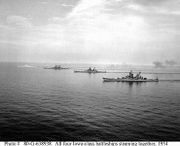
When brought into service during the final years of World War II, the Iowa-class battleships were assigned to operate in the Pacific Theatre. By this point in the war aircraft carriers had displaced battleships as the primary striking arm of the both United States Navy and the Imperial Japanese Navy. As a result of this shift in tactics U.S. battleships of all classes were relegated to the secondary role of carrier escorts, and were assigned to the Fast Carrier Task Force to provide anti-aircraft screening for U.S. aircraft carriers and perform shore bombardment.[24] At the end of the war, Iowa, New Jersey and Wisconsin were decommissioned and placed in the mothball fleet;[N 3] construction was halted on the two incomplete ships, Illinois and Kentucky.[27][28]
The Iowas were recalled in 1950 with the outbreak of the Korean War, and provided naval artillery support for U.N. forces for the entire duration of the war before being returned to mothballs in 1955 after hostilities ceased. In 1968, to help alleviate U.S. air losses over North Vietnam[29] and to deliver the ordnance necessary for the escalating war in Vietnam, New Jersey was recommissioned, and as the only active battleship in the world in 1968, departed for the gunline off the Vietnamese coast. From approximately 6 April 1968 until 17 December 1969, New Jersey operated in the waters off the Vietnamese Demilitarized Zone, firing nearly 6,000 16-inch (406 mm) shells and well over 14,000 rounds of 5-inch (127 mm) shells at communist targets, before departing the gunline;[30][31] she was decommissioned the following year.[31][32]
In the 1980s, all of the Iowas were recommissioned as part of President Ronald Reagan's plan to rebuild the U.S. military and create a 600-ship Navy. The ships provided a counter to the new Soviet Orlan-class large missile cruisers, better known in the West as the Kirov-class battlecruisers.[33][34][35] Each battleship was modernized to carry electronic warfare suites, close-in weapon systems (CIWS) for self-defense, and missiles.[N 4][37] They became the centerpieces of their own battleship battle groups (BBBGs).[N 5] Their missions in the 1980s and early 1990s included the U.S. intervention in the Lebanese Civil War following the 1983 Beirut barracks bombing and Desert Storm in 1991, first as part of Operation Desert Shield in 1990 and then as part of Operation Desert Storm in January through February 1991. Decommissioned for the last time due to budgetary restraints[N 6] in the early 1990s, the Iowas were split into two groups: those retained in the United States Navy reserve fleets (better known as the "mothball fleet") and those donated for use as museum ships.[40]
In 1996, the National Defense Authorization Act led Iowa and Missouri to be struck from the Naval Vessel Register. Missouri was donated to the USS Missouri Memorial Association of Pearl Harbor, Hawaii, for use as a museum ship. Iowa was set to be donated with Missouri, but was reinstated to the Naval Vessel Register after the Strom Thurmond National Defense Authorization Act of 1999 allowed New Jersey to be donated as a museum ship.[41] The last two Iowa-class battleships were removed from the mothball fleet in 2006; Wisconsin has been formally donated for use as a museum ship, while Iowa remains stricken and available for donation.[42][43]
Ships
USS Iowa (BB-61)
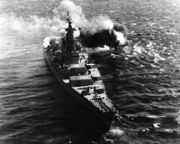
Iowa was ordered 1 July 1939, laid down 27 June 1940, launched 27 August 1942, and commissioned 22 February 1943. She conducted a shakedown cruise in Chesapeake Bay before sailing to Naval Station Argentia, Newfoundland, to be ready in case the German battleship Tirpitz entered the Atlantic.[44] Transferred to the Pacific Fleet in 1944, Iowa made her combat debut in February and participated in the campaign for the Marshall Islands.[45] The ship later escorted U.S. aircraft carriers conducting air raids in the Marianas campaign, and then was present at the Battle of Leyte Gulf.[45] During the Korean War, Iowa bombarded enemy targets at Songjin, Hungnam, and Kojo, North Korea. Iowa returned to the U.S. for operational and training exercises before being decommissioned.[46] Reactivated in the early 1980s, Iowa operated in the Atlantic Fleet, cruising in North American and European waters for most of the decade and participating in joint military exercises with European ships.[47] On 19 April 1989, 47 sailors were killed following an explosion in her No. 2 turret.[48] In 1990, Iowa was decommissioned for the last time and placed in the mothball fleet. She was stricken from the Naval Vessel Register on 17 March 2006. Iowa is currently anchored as part of the National Defense Reserve Fleet in Suisun Bay and is available for donation as a museum and memorial.[43]
USS New Jersey (BB-62)
New Jersey was ordered 1 July 1939, laid down 16 September 1940, launched 7 December 1942, and commissioned 23 May 1943. New Jersey completed fitting out and trained her initial crew in the Western Atlantic and Caribbean before transferring to the Pacific Theatre in advance of the planned assault on the Marshall Islands, where she screened the U.S. fleet of aircraft carriers from enemy air raids. At the Battle of Leyte Gulf, the ship protected carriers with her anti-aircraft guns. New Jersey then bombarded Iwo Jima and Okinawa. During the Korean War, the ship pounded targets at Wonsan, Yangyang, and Kansong. Following the ceasefire, New Jersey conducted training and operation cruises until she was decommissioned. Recalled to duty in 1968, New Jersey reported to the gunline off the Vietnamese coast, delivering nearly 6,000 rounds of 16-inch (406 mm) gunfire and over 14,000 rounds of 5-inch (127 mm) shells before departing the line in December 1968.[30] She was decommissioned the following year.[32] Reactivated in 1982 under the 600-ship Navy program,[49] New Jersey was sent to Lebanon to protect U.S. interests and U.S. Marines, firing her main guns at Druze and Syrian positions in the Bekaa Valley east of Beirut.[50] Decommissioned for the last time 8 February 1991, New Jersey was briefly retained on the Naval Vessel Register before being donated to the Home Port Alliance of Camden, New Jersey for use as a museum ship.[51]
USS Missouri (BB-63)
Missouri was ordered 12 June 1940, laid down 6 January 1941, launched 29 January 1944, and commissioned 11 June 1944. Missouri conducted her trials off New York with shakedown and battle practice in Chesapeake Bay before transferring to the Pacific Fleet, where she screened U.S. aircraft carriers involved in offensive operations against the Japanese before reporting to Okinawa to shell the island in advance of the planned landings. Following the bombardment of Okinawa, Missouri turned her attention to Honshū and Hokkaidō, shelling the islands and screening U.S. carriers involved in combat operations against Japanese positions. She garnered international attention in September 1945 when representatives of the Empire of Japan boarded the battleship to sign the documents of unconditional surrender to the Allied powers. After World War II, Missouri turned her attention to conducting training and operational cruises before being dispatched to Korea at the outbreak of the Korean War. Missouri served two tours of duty in Korea before being decommissioned in 1956. Reactivated 1984 as part of the 600-ship Navy plan, Missouri was sent on operational cruises until being assigned to Operation Earnest Will in 1988. In 1991, Missouri participated in Operation Desert Storm, firing 28 Tomahawk Missiles and 759 sixteen-inch (406 mm) shells at Iraqi targets along the coast.[30][52] Decommissioned for the last time in 1992, Missouri was donated to the USS Missouri Memorial Association of Pearl Harbor, Hawaii, for use as a museum ship in 1998.[53][54]
USS Wisconsin (BB-64)
_launching_Tomahawk.jpg)
Wisconsin was ordered 12 June 1940, laid down 25 January 1942, launched 7 December 1943, and commissioned 16 April 1944. After trials and initial training in Chesapeake Bay, she transferred to the Pacific Fleet in 1944 and was assigned to protect the U.S. fleet of aircraft carriers involved in operations in the Philippines until summoned to Iwo Jima to bombard the island in advance of the Marine landings. Afterward, she proceeded to Okinawa, bombarding the island in advance of the allied amphibious assault. In mid-1945 Wisconsin turned her attention to bombarding the Japanese home islands until the surrender of Japan in August. Reactivated in 1950 for the Korean War, Wisconsin served two tours of duty, assisting South Korean and UN forces by providing call fire support and shelling targets. In 1956, the bow of the uncompleted USS Kentucky was removed and grafted on Wisconsin, which had collided with the destroyer USS Eaton. Decommissioned in 1958, Wisconsin was placed in the reserve fleet at the Philadelphia Naval Yard[55] until reactivated in 1986 as part of the 600-ship Navy plan. In 1991, Wisconsin participated in Operation Desert Storm, firing 24 Tomahawk Missiles at Iraqi targets, and expending 319 16-inch (406 mm) shells[30] at Iraqi troop formations along the coast. Decommissioned for the last time 30 September 1991, Wisconsin was placed in the reserve fleet until struck from the Naval Vessel Register on 17 March 2006 so she could be transferred for use as a museum ship. Wisconsin is currently berthed at the Nauticus maritime museum in Norfolk, Virginia.[42]
Illinois (BB-65)
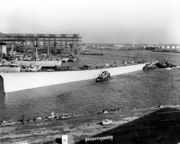
Hull BB-65 was originally to be Montana,[56] however changes in shipbuilding priority during World War II resulted in her being reordered as an Iowa-class battleship.[57] Illinois was ordered 9 September 1940 and laid down 15 January 1945. Construction was canceled 11 August 1945 when Illinois was 22% complete.[58] She was sold for scrap in September 1958.[27][59]
Kentucky (BB-66)
Hull BB-66 was originally to be Ohio, the second Montana-class battleship[56] however changes in shipbuilding priority during World War II resulted in her being reordered as an Iowa-class battleship.[57] Kentucky was ordered 9 September 1940 and laid down on 6 December 1944. Construction was suspended 17 February 1947 when Kentucky was 72% complete. She was informally launched 20 January 1950 to clear a dry-dock for repairs to Missouri, which had run aground. In 1956, Kentucky's bow was removed and shipped in one piece across Hampton Roads, where it was grafted on the battleship Wisconsin, which had collided with the destroyer Eaton.[55] Later, Kentucky's engines were salvaged and installed on the fast combat support ships Sacramento and Camden.[60][61] Proposals were made to complete Kentucky as a guided missile battleship, but these plans were never realized.[61] Ultimately, Kentucky was sold to Boston Metals Co. for scrap on 31 October 1958.[28][62]
Armament
Main battery
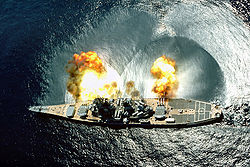
The primary armament of an Iowa-class battleship is nine 16-inch (406 mm)/50-caliber Mark 7 naval guns, which are housed in three three-gun turrets, two forward and one aft. The guns fire projectiles weighing from 1,900 to 2,700 pounds (860 to 1,200 kg) at a muzzle velocity of 2,690 ft/s (820 m/s) to a maximum range of 42,345 yards (38,720 m) (24.06 mi) using an armor-piercing shell. At maximum range the projectile spends almost 1½ minutes in flight. The maximum firing rate for each gun is two rounds per minute.[63] The turrets are "three-gun", not "triple", because each barrel can be elevated independently; they can also be fired independently. The ship could fire any combination of its guns, including a broadside of all nine.
Radar range estimation provided a significant accuracy advantage over earlier ships with optical rangefinders. Off Truk Atoll on 16 February 1944 Iowa engaged the Japanese destroyer Nowaki at a range of 35,700 yards (32.6 km). While she did not hit the destroyer she did straddle her, setting a record for the longest ranged straddle in history.[64]
Secondary battery
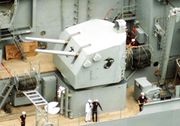
The secondary battery of the ship consists of 5-inch (127 mm) Mark 12 guns in 10 twin mounts, five each to port and starboard, and four Mark 37 Gun Fire Control Systems. These guns were introduced on destroyers in 1934, but by World War II had been installed on nearly every major U.S. warship.[65] The secondary battery was intended to fight off aircraft. Its effectiveness soon declined as Japanese airplanes became faster, then rose again toward the end of the war because of an upgrade to the Mark 37 Fire Control System and proximity-fused 5-inch (130 mm) shells. During the 1980s modernization, four twin mounts were removed to make room for missiles, the two farthest aft and the two at mid-ship on each side.[66]
Anti-aircraft batteries
All four Iowa-class battleships were outfitted with Oerlikon 20 mm and Bofors 40 mm, both of which were among the most heavily produced anti-aircraft guns of World War II. The Oerlikon 20 mm AA gun remained the primary anti-aircraft weapon of the United States Navy until the introduction of the Bofors 40 mm gun in 1943,[67] while the Bofors 40 mm gun accounted for roughly half of all Japanese aircraft shot down between 1 October 1944 and 1 February 1945.[68] Both of these batteries were replaced with Phalanx CIWS mounts when the battleships were modernized in the 1980s.[69] Iowa, New Jersey, and Missouri received the Phalanx Block 0 variant, while Wisconsin received the first operation Phalanx Block I mount when she recommissioned in 1988.[70]
Missiles
During modernization in the 1980s each of the Iowa-class battleships received a complement of BGM-109 Tomahawk Land Attack Missiles (TLAMs) for use against enemy targets on land and a complement of RGM-84 Harpoon anti-ship missiles for use against enemy ships. With an estimated range of 1,000 nautical miles (1,900 km; 1,200 mi)[71] for the Tomahawk missile system and 75 nautical miles (139 km; 86 mi)[72] for the Harpoon missile system these two missile systems displaced the sixteen-inch guns and their maximum range of 42,345 yards (38,720 m) (24.06 mi)[63] to become the longest-ranged weapons on the battleships during the 1980s. At one point, the NATO Sea Sparrow was to be installed on the reactivated battleships; however, it was determined that the system could not withstand the overpressure effects from firing the main battery.[37]
Armor
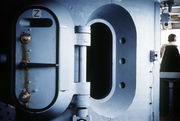
Like all battleships, the Iowas carried heavy armor protection against shellfire and bombs, and underwater protection against torpedoes. The Iowas' armor scheme was modeled on that of the preceding South Dakota class, and designed to give an immune zone against fire from 16-inch/45-caliber guns between 18,000 and 30,000 yards (16,000 and 27,000 m) away. The magazines and engine rooms were protected by an armored belt 12.2 inches (310 mm) thick, which sloped to give an effective vertical thickness of 13.5 inches (340 mm). Their armor was not sufficient to protect against guns equivalent to their own 16-inch/50-caliber guns; increasing the armor would have increased weight and reduced speed.[73]
Missouri and Wisconsin incorporated the most significant change in armor from the South Dakota class: the increase from 11.3 inches (290 mm) to 14.5 inches (370 mm) of the vertical armor on the forward armored bulkhead, the conning tower, and the turret barbettes. The extra armor provided protection from fire directly ahead, which was considered more likely given the high speed of the Iowa class.[74]
The Iowa-class torpedo defense was virtually the same as the South Dakota's. Each side of the ship was protected below the waterline by two tanks mounted outside the armored belt, and separated by a bulkhead. These tanks were initially planned to be empty, but in practice were filled with water or fuel oil. The armored belt tapered to a thickness of 4 inches (100 mm) below the waterline. Behind the armored belt there was a void, and then another bulkhead. The outer hull was intended to detonate a torpedo, with the outer two compartments absorbing the shock and with any splinters or debris being stopped by the armored belt and the empty compartment behind it. In 1939, the Navy discovered that this system was considerably less effective than earlier torpedo defense systems, but by then it was too late to do anything about the design.[75]
Aircraft
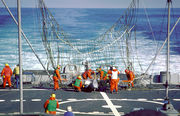
During their service careers the Iowas have carried a number of different aircraft, beginning with the Vought OS2U Kingfisher[4] and Curtiss SC Seahawk,[76] both of which were employed to spot for the battleship's main gun batteries, and in a secondary capacity, perform search and rescue missions.[4]
By the time of the Korean War, helicopters had replaced floatplanes on the Iowa class. They added a logistics role to gunnery spotting and search-and-rescue; helicopters ferried troops and supplies between ships and to and from land bases. Like the seaplanes before them, the helicopters had no hangar facilities, but the Iowas did have support facilities for five types of helicopters: the UH-1 Iroquois, SH-2 Seasprites, CH-46 Sea Knight, CH-53 Sea Stallion and the LAMPS III SH-60B Seahawk.[4]
By the 1980s the helicopters had given way to unmanned aerial vehicle (UAVs), the first of which was the RQ-2 Pioneer.[6] Pioneer UAVs carried a video camera in a pod under the belly of the aircraft, which transmitted live video back to the ship so that the operators could observe enemy actions or the fall of shot during naval gunnery.[6] Pioneer garnered international attention for its use during the 1991 Gulf War, when it saw extensive use from Missouri and Wisconsin.[6]
Engineering plant
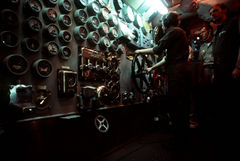
The Iowa-class battleships are the fastest battleships ever launched, theoretically capable of sustained speeds of 35 knots (65 km/h) or better.[N 7] This is due in part to the use of an empirical formula for predicting a ship's maximum speed that was originally developed for 12-meter (39 ft) yachts. The formula was on scale-model studies in flumes of various hull forms and propellers, and was adopted after various tests at the David Taylor Model Basin. It quickly became apparent that propeller cavitation caused a drop in efficiency at speeds over 30 knots (56 km/h). Propeller design therefore took on new importance.[77][N 8]
The engineering plant on Iowa and Missouri consists of four General Electric cross-compound steam turbine engines, each driving a single shaft that turns one screw. The two outboard screws on the Iowa class have four blades and are just over 18 feet (5.5 m) in diameter. The two inboard screws have five blades and are about 17.5 feet (5.3 m) in diameter.[1] The equivalent machinery on New Jersey and Wisconsin was provided by Westinghouse. Eight Babcock and Wilcox M-Type boilers operate at 600 pounds per square inch (4,100 kPa) with a maximum superheater outlet temperature of 875 °F (468 °C). In normal steaming four boilers were operated; this was sufficient to power the ships at speeds up to 27 knots. For higher speeds all eight boilers were lit.[79]
Electricity drives many systems aboard ship, including rotating the turrets and elevating the guns. Each of the four engine rooms has a pair of Ship's Service Turbine Generators (SSTGs)[80] manufactured by Westinghouse. Each SSTG generates 1.25 MW for a total of 10 MW of electricity. The SSTGs are powered by steam from the same boilers that feed the engines. For backup, the ship has a pair of 250-kW diesel generators.[1] To allow battle-damaged electrical circuits to be repaired or bypassed, the lower decks of the ship have a Casualty Power System whose large three-wire cables and wall outlets called "biscuits" can be used to re-route power.[81]
Radar and electronic warfare systems
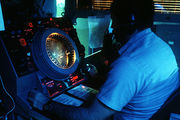
Each of the four Iowa-class battleships are equipped with the AN/SPS-49 Radar Set, an L-band, long-range, two-dimensional, air-search radar system that provides automatic detection and reporting of targets within its surveillance volume. The AN/SPS-49 performs accurate centroiding of target range, azimuth, amplitude, electronic countermeasures level background, and radial velocity with an associated confidence factor to produce contact data for command and control systems. Additionally, the contact range and bearing information is provided for display on standard plan position indicator consoles.[82]
The Iowa-class battleships are equipped with the Radar Set AN/SPS-67, a short-range, two-dimensional, surface-search/navigation radar system that provides highly accurate surface and limited low-flyer detection and tracking capabilities. The AN/SPS-67 is a solid-state replacement for the AN/SPS-10 radar, using a more reliable antenna and incorporating standard electronic module technology for simpler repair and maintenance. The AN/SPS-67 provides excellent performance in rain and sea clutter, and is useful in harbor navigation, since the AN/SPS-67 is capable of detecting buoys and small obstructions without difficulty.[83]
Reactivation proposals
"In summary, the committee is concerned that the Navy has foregone the long-range fire support capability of the battleship, has given little cause for optimism with respect to meeting near-term developmental objectives, and appears unrealistic in planning to support expeditionary warfare in the mid-term. The committee views the Navy's strategy for providing naval surface fire support as 'high risk,' and will continue to monitor progress accordingly."
After World War II, the United States maintained the four Iowa-class battleships in the United States Navy reserve fleets, better known as the "mothball fleet", and on several occasions reactivated these battleships for naval gunfire support. The U.S. Navy has held onto its battleships long after the expense and the arrival of aircraft and precision guided munitions led other nations to scrap their big-gun fleets.[85] The United States Congress is largely responsible for this. The lawmakers argue that the battleships' large-caliber guns have a militarily useful destructive power lacking in the smaller, cheaper, and faster guns mounted by U.S. cruisers and destroyers.[86]
In response, the Navy has pointed to the cost of reactivating the two Iowa class battleships to their decommissioned capability. The Navy estimates costs in excess of $500 million,[86][N 9] but this does not include an additional $110 million needed to replenish the gunpowder for the 16-inch (406 mm) guns because a survey found the powder to be unsafe. The Navy's program management office estimates that reactivation would take 20 to 40 months, given the loss of corporate memory and the shipyard industrial base.[86]
Reactivating the battleships would require a wide range of battleship modernization improvements, according to the Navy's program management office. At a minimum, these modernization improvements include command and control, communications, computers, and intelligence equipment; environmental protection (including ozone-depleting substances); a plastic-waste processor; pulper/shredder and wastewater alterations; firefighting/fire safety and women-at-sea alterations; a modernized sensor suite (air and surface search radar); and new combat and self-defense systems.[86] The Navy's program management office identified other issues that would strongly discourage the Navy from reactivating and modernizing the battleships. For example, the number of personnel needed to operate the battleships would be extensive, and the skills needed may not be available or easily reconstituted.[N 10] Other issues include the age and unreliability of the battleships' propulsion systems and the fact that the Navy no longer maintains the capability to manufacture their 16-inch (410 mm) gun system components and ordnance.[86]
Although the Navy firmly believes that the battleships are no longer needed, members of the United States Congress remain skeptical about the Navy's plan to replace its battleships with specially designed destroyers.[87] The U.S. House of Representatives has asked that the battleships be kept in a state of readiness should they ever be needed again.[88]
Notes
- ↑ Furthermore, the armor was distributed to best protect against close-in hits, as these cruiser-killers would generally fight alone and possibly in poor weather, which would hamper visibility and range (radars had not been fitted to ships by this point). On the other hand, a true battleship could be designed to only deal with long-range threats as they would be escorted by destroyers and possibly cruisers, both of which would find and engage any enemies before they approached the capital ship, regardless of weather.[12]
- ↑ The belt armor was increased from 8.1 inches (210 mm) to 12.6 inches (320 mm); the deck from 2.3 inches (58 mm) to 5 inches (130 mm); the splinter armor to 3.9 inches (99 mm); the turret armor from 9 inches (230 mm) on the front, 6 inches (150 mm) on the side, and 5 inches (130 mm) on the rear to 18 inches (460 mm), 10 inches (250 mm) and 8 inches (200 mm), respectively.[15]
- ↑ As part of the post World War II drawdown, three of the Iowa-class battleships had been de-activated and decommissioned; however, President Truman refused to allow Missouri to be decommissioned. Against the advice of Secretary of Defense Louis Johnson, Secretary of the Navy John L. Sullivan, and Chief of Naval Operations Louis E. Denfeld, Truman ordered Missouri to be maintained with the active fleet partly because of his fondness for the battleship and partly because the battleship had been commissioned by his daughter Margaret Truman.[25][26]
- ↑ During this reactivation, the Navy considered various ideas to remove the No. 3 gun turrets from the battleships and replace them with servicing facilities for 12 AV-8B Harrier STOVL jumpjets. Plans for such a conversion were dropped in 1984.[36]
- ↑ A Battleship Battle Group consisted of one Ticonderoga-class cruiser, one Kidd-class destroyer or Arleigh Burke-class destroyer, one Spruance-class destroyer, three Oliver Hazard Perry-class frigate, and one support ship.[38]
- ↑ A Government Accountability Office report on the operating cost for each individual Iowa-class battleship in 1991 reported that it cost the United States Navy $58 million to operate each individual battleship. Adjusted for inflation on the Consumer Price Index, each individual battleship would cost just over $88.5 million to operate in 2008 dollars. This number does not take into consideration the cost of specialty items and other unique components that may be needed to keep a battleship operational.[39]
- ↑ The actual speed of the Iowa-class battleships varies from source to source. The most commonly cited figures for the battleship class are 32 or 33 knots, but it appears that such speeds have never actually been attained in speed tests. Theoretically, the battleships of the Iowa-class should be able to cruise at nearly 35 knots, but this speed appears to be abnormally high and does not take into account factors like ocean resistance and weight. The fastest confirmed speed for the class is just over 31 knots, a speed attained by New Jersey during tests.[3]
- ↑ These mathematical formulas still stand today, and have been used to design hulls for U.S. ships and to predict the speed of those hulls for the ships when commissioned, including nuclear powered ships like the U.S. fleet of Nimitz-class supercarriers.[78]
- ↑ This number is based on 1999 estimate with a 4% annual inflation rate. The U.S. Navy reported in the April 1987 edition of All Hands that the original cost of bringing the battleships back in the 1980s was $110 million per ship, but the actual cost after modernization and recommissioning was $455 million. See: Bureau of Naval Personnel, "Back on the battle line".
- ↑ The U.S. Navy reported in the April 1987 edition of All Hands that while battleships have larger crews than other vessels the level of training required and the criticality of that training were less than that required of a crew aboard an Oliver Hazard Perry-class frigate. See: Bureau of Naval Personnel, "Back on the battle line".
References
- ↑ 1.00 1.01 1.02 1.03 1.04 1.05 1.06 1.07 1.08 1.09 1.10 1.11 Newhart, pp. 90–101
- ↑ 2.0 2.1 2.2 2.3 Friedman, p. 449
- ↑ 3.0 3.1 3.2 Friedman, p. 317
- ↑ 4.0 4.1 4.2 4.3 Smigielski, Adam (in Polish). Biblioteka Magazynu MSiO n°03 - Amerykanskie Olbrzymy. 3. Biblioteka Magazynu MSiO.
- ↑ 5.0 5.1 5.2 5.3 5.4 Johnston and McAuley, pp. 108–23.
- ↑ 6.0 6.1 6.2 6.3 Pike, John (5 March 2000). "Pioneer Short Range (SR) UAV". Federation of American Scientists. http://www.fas.org/irp/program/collect/pioneer.htm. Retrieved 2 March 2007.
- ↑ Garzke and Dulin, p. 3
- ↑ Friedman, pp. 181–182
- ↑ Friedman, pp. 186–187
- ↑ Friedman, p. 243
- ↑ Garzke and Dulin, pp. 3, 6
- ↑ 12.0 12.1 12.2 Friedman, p. 309
- ↑ Garzke and Dulin, p. 107
- ↑ Friedman, pp. 309, 311
- ↑ 15.0 15.1 Friedman, p. 310
- ↑ Friedman, pp. 271, 309
- ↑ Friedman, pp. 309–310
- ↑ Friedman, pp. 310–311
- ↑ Friedman, p. 311
- ↑ Friedman, p. 307
- ↑ Friedman, pp. 311–312
- ↑ Friedman, p. 313
- ↑ Friedman, pp. 313–314
- ↑ Johnston, p. 161
- ↑ Stillwell, Paul (February 1999). "USS Missouri: Served in World War II and Korean War". American History. OCLC 30148811. ISSN 1076-8866. http://www.historynet.com/magazines/american_history/3037591.html. Retrieved 3 December 2007.
- ↑ Adamski, Mary (9 August 1998). "Mighty Mo anchors $500,000 donation". Honolulu Star-Bulletin. http://starbulletin.com/1999/08/09/news/story2.html. Retrieved 14 June 2007.
- ↑ 27.0 27.1 "Illinois (BB 65)". Naval Vessel Register. http://www.nvr.navy.mil/nvrships/details/BB65.htm. Retrieved 17 January 2010.
- ↑ 28.0 28.1 "Kentucky (BB 66)". Naval Vessel Register. http://www.nvr.navy.mil/nvrships/details/BB66.htm. Retrieved 17 January 2010.
- ↑ Neubeck, p. 42
- ↑ 30.0 30.1 30.2 30.3 Polmar, p. 129
- ↑ 31.0 31.1 Stillwell, 1986, p. 222
- ↑ 32.0 32.1 "New Jersey". Dictionary of American Naval Fighting Ships. Navy Department, Naval History & Heritage Command. http://www.history.navy.mil/danfs/n4/new_jersey-ii.htm. Retrieved 27 May 2010.
- ↑ Middleton, Drew (13 March 1981). "Pentagon likes budget proposal, but questions specifics". The New York Times: p. A14.
- ↑ Bishop, p. 80
- ↑ Miller and Miller, p. 114
- ↑ "BB-61 Iowa-class Aviation Conversion". GlobalSecurity.org. 27 November 2005. http://www.globalsecurity.org/military/systems/ship/bb-61-av.htm. Retrieved 19 May 2007.
- ↑ 37.0 37.1 Horan, Donald J. (20 April 1981). "Update of the Issues Concerning the Proposed Reactivation of the Iowa class battleships and the Aircraft Carrier Oriskany" (PDF). United States General Accounting Office. pp. 3–18. http://archive.gao.gov/f0102/115403.pdf. Retrieved 25 May 2005.
- ↑ Lightbody and Poyer, pp. 338, 339
- ↑ "Defense Budget: Potential Reductions to DOD's Ammunition Budgets" (pdf). United States General Accounting Office. 17 September 1990. pp. 29. http://archive.gao.gov/d23t8/142247.pdf. Retrieved 8 August 2009.
- ↑ National Defense Authorization Act of 1996PDF (1.68 MB). 104th Congress, House of Representatives. p. 237. Retrieved on 17 December 2006.
- ↑ "Strom Thurmond National Defense Authorization Act of 1999 (Subtitle B-Naval Vessels and Shipyards)" (pdf). 105th Congress, United States Senate and House of Representatives. pp. 200–201. http://www.dod.mil/dodgc/olc/docs/1999NDAA.pdf. Retrieved 12 March 2007.
- ↑ 42.0 42.1 "Wisconsin (BB 64)". Naval Vessel Register. http://www.nvr.navy.mil/nvrships/details/BB64.htm. Retrieved 30 January 2010.
- ↑ 43.0 43.1 "Iowa (BB 61)". Naval Vessel Register. http://www.nvr.navy.mil/nvrships/details/BB61.htm. Retrieved 30 January 2010.
- ↑ Garzke and Dulin, p. 115
- ↑ 45.0 45.1 Garzke and Dulin, p. 120
- ↑ "Iowa". Dictionary of American Naval Fighting Ships. Navy Department, Naval History & Heritage Command. http://www.history.navy.mil/danfs/i2/iowa-iii.htm. Retrieved 27 May 2010.
- ↑ Garzke and Dulin, pp. 218–222
- ↑ Thompson, p. 261
- ↑ Stillwell, 1986, pp. 243–251
- ↑ Stillwell, 1986, pp. 261–273
- ↑ "New Jersey (BB 62)". Naval Vessel Register, United States Navy. 19 July 2002. http://www.nvr.navy.mil/nvrships/details/BB62.htm. Retrieved 28 January 2010.
- ↑ Stillwell 1996, p. 327
- ↑ "Missouri (BB 63)". Naval Vessel Register, United States Navy. 19 July 2002. http://www.nvr.navy.mil/nvrships/details/BB63.htm. Retrieved 30 January 2010.
- ↑ "Missouri". Dictionary of American Naval Fighting Ships. Navy Department, Naval History & Heritage Command. http://www.history.navy.mil/danfs/m12/missouri-iv.htm. Retrieved 27 May 2010.
- ↑ 55.0 55.1 "Wisconsin". Dictionary of American Naval Fighting Ships. Navy Department, Naval History & Heritage Command. http://www.history.navy.mil/danfs/w10/wisconsin-ii.htm. Retrieved 27 May 2010.
- ↑ 56.0 56.1 Pike, John (2008). "BB-67 Montana Class". GlobalSecurity.org. http://www.globalsecurity.org/military/systems/ship/bb-67.htm. Retrieved 13 January 2008.
- ↑ 57.0 57.1 Johnston, pp. 108–123
- ↑ Garzke and Dulin, p. 137
- ↑ "Illinois". Dictionary of American Naval Fighting Ships. Navy Department, Naval History & Heritage Command. http://www.history.navy.mil/danfs/i1/illinois.htm. Retrieved 27 May 2010.
- ↑ "Sacramento". Dictionary of American Naval Fighting Ships. Navy Department, Naval History & Heritage Command. http://www.history.navy.mil/danfs/s2/sacramento-iii.htm. Retrieved 21 February 2010.
- ↑ 61.0 61.1 Rogers, J. David. "Development of the World's Fastest Battleships" (pdf). http://web.mst.edu/~rogersda/american&military_history/World%27s%20Fastest%20Battleships.pdf. Retrieved 30 May 2010.
- ↑ "Kentucky". Dictionary of American Naval Fighting Ships. Navy Department, Naval History & Heritage Command. http://www.history.navy.mil/danfs/k3/kentucky.htm. Retrieved 27 May 2010.
- ↑ 63.0 63.1 DiGiulian, Tony (22 November 2009). "United States of America 16"/50 (40.6 cm) Mark 7". Navweaps.com. http://www.navweaps.com/Weapons/WNUS_16-50_mk7.htm. Retrieved 23 January 2010.
- ↑ Fischer, Brad D.; Jurens, W. J. (2006). "Fast Battleship Gunnery during World War II: A Gunnery Revolution, Part II". Warship International (Toledo, OH: International Naval Research Organization) XLIII (1): 83. ISSN 0043-0374.
- ↑ DiGiulian, Tony (27 March 2008). "United States of America 5"/38 (12.7 cm) Mark 12". Navweaps.com. http://www.navweaps.com/Weapons/WNUS_5-38_mk12.htm. Retrieved 25 July 2008.
- ↑ Stillwell, 1996, p. 256
- ↑ DiGiulian, Tony (14 May 2008). "British, Swiss and USA 20 mm/70 (0.79") Oerlikon Marks 1, 2, 3 and 4". Navweaps.com. http://www.navweaps.com/Weapons/WNUS_2cm-70_mk234.htm. Retrieved 25 July 2008.
- ↑ DiGiulian, Tony (14 May 2008). "Sweden, British, USA, German and Japanese Bofors 40 mm/56 (1.57") Model 1936". Navweaps.com. http://www.navweaps.com/Weapons/WNUS_4cm-56_mk12.htm. Retrieved 25 July 2008.
- ↑ Friedman, p. 395
- ↑ DiGiulian, Tony (13 October 2004). "United States of America Tomahawk Cruise Missile BGM-109". Navweaps.com. http://www.navweaps.com/Weapons/WMUS_Tomahawk.htm. Retrieved 16 May 2010.
- ↑ Parsch, Andreas (8 July 2008). "AGM/RGM/UGM-84". Directory of U.S. Military Rockets and Missiles. designation-systems.net. http://www.designation-systems.net/dusrm/m-84.html. Retrieved 16 May 2010.
- ↑ Friedman, p. 314
- ↑ Friedman, p. 314
- ↑ Friedman, p. 285
- ↑ Bridgeman, pp. 221–22
- ↑ Rogers, pp. 5–6
- ↑ Rogers, p. 15
- ↑ Preston, p. 259
- ↑ For a diagram and statistics of SSTGs, see: Hochscheidt, Mike. "Ship's Service Turbine Generator". http://web.archive.org/web/20080316204513/http://www.nmc.edu/~mhochscheidt/STEAM+NOTEBOOK/sstg.htm. Retrieved 25 July 2008.
- ↑ Defense Technical Information Center. "Casualty power" (doc). United States Department of Defense. http://www.dtic.mil/dticasd/sbir/sbir032/n205.doc. Retrieved 14 March 2007.
- ↑ "AN/SPS-49 Very Long-Range Air Surveillance Radar". GlobalSecurity.org. 27 April 2005. http://www.globalsecurity.org/military/systems/ship/systems/an-sps-49.htm. Retrieved 14 March 2007.
- ↑ "AN/SPS-67". GlobalSecurity.org. 27 April 2005. http://www.globalsecurity.org/military/systems/ship/systems/an-sps-67.htm. Retrieved 14 March 2007.
- ↑ "National Defense Authorization Act of 2007" (PDF). pp. 193–94. http://www.gpoaccess.gov/serialset/creports/pdf/hr109-452/title2.pdf. Retrieved 12 March 2007.
- ↑ Government Accountability Office (11 June 1999). "Naval Surface Fire Support Program Plans and Costs (GAO/NSIAD-99-91)" (PDF). Government Accountability Office. http://www.gao.gov/archive/1999/ns9991.pdf. Retrieved 30 May 2010.
- ↑ 86.0 86.1 86.2 86.3 86.4 Government Accountability Office (19 November 2004). "Information on Options for Naval Surface Fire Support (GAO-05-39R)" (PDF). Government Accountability Office. http://www.gao.gov/new.items/d0539r.pdf. Retrieved 30 May 2010.
- ↑ Government Accountability Office (14 September 1999). "Evaluation of the Navy's 1999 Naval Surface Fire Support Assessment (GAO/NSIAD-99-225)" (PDF). Government Accountability Office. http://www.gao.gov/archive/1999/ns99225.pdf. Retrieved 30 May 2010.
- ↑ "Report 109–452. National Defense Authorization Act of 2007." 109th Congress, House of Representatives. p. 68.
Bibliography
- Bishop, Chris (1988). The Encyclopedia of World Sea Power. New York: Crescent Books. ISBN 0517653427. OCLC 18199237.
- Bridgeman, Leonard (1946). Jane's Fighting Aircraft of World War II. London: Studio. ISBN 1 85170 493 0.
- Bureau of Naval Personnel (April 1987). "Back on the battle line" (PDF). All Hands (Washington, D.C.: United States Navy) 841: 28–29. ISSN 0002-5577. OCLC 2555618. http://www.navy.mil/media/allhands/acrobat/ah198704.pdf. Retrieved 30 May 2010.
- Friedman, Norman (1986). U.S. Battleships: An Illustrated Design History. Annapolis: Naval Institute Press. ISBN 0870-2-1715-1. OCLC 12214729.
- Garzke, William H.; Robert O. Dulin, Jr. (1995). Battleships: United States Battleships 1935–1992 (Rev. and updated ed.). Annapolis: Naval Institute Press. ISBN 9780870210990. OCLC 29387525.
- Johnston, Ian C.; McAuley, Rob (2002). The Battleships. London: Channel 4. ISBN 0752261886. OCLC 59495980.
- Keegan, John (2000). World War II: A Visual Encyclopedia. London: PRC Publishing. ISBN 1-85585-878-9. OCLC 45188820.
- Lightbody, Andy; Poyer, Joe (1990). The Complete Book of U.S. Fighting Power. New York: Beekman House. ISBN 0517032988. OCLC 24047998.
- Miller, David; Miller, Chris (1986). Modern Naval Combat. London: Salamander Books. ISBN 0861012313. OCLC 17397400.
- Neubeck, Ken (2002). F-105 Thunderchief In Action. Carrollton: Squadron/Signal Publishing #185. ISBN 089-7474-473. OCLC 475321332.
- Newhart, Max R. (2007). American Battleships: A Pictorial History of BB-1 to BB-71 with Prototypes main and Texas. Missoula, Montana: Pictorial Histories Publishing Company, Inc.. pp. 90–101. ISBN 1-57510-004-5.
- Polmar Norman. The Naval Institute Guide to the Ships and Aircraft of the US Fleet. 2001, Naval Institute Press. ISBN 1-5575 0656 6.
- Stillwell, Paul (1986). Battleship New Jersey: An Illustrated History. Annapolis, Maryland: Naval Institute Press. ISBN 0-870821-029-7.
- Thompson II, Charles C. (1999). A Glimpse of Hell: The Explosion on the USS Iowa and Its Cover-Up. W. W. Norton. ISBN 0-393-04714-8.
Further reading
- Bonner, Kit; Bonner, Carolyn (1998). "Explosion". Great Naval Disasters: U.S. Naval Accidents in the 20th Century. Osceola, Wisconsin: MBI Publishing. ISBN 0-7603-0594-3. OCLC 39545709.
- Butler, John A. (1995). Strike Able-Peter: The Stranding and Salvage of the USS Missouri. Annapolis, Maryland: Naval Institute Press. ISBN 1557500940.
- Holland, W. J.; Naval Historical Foundation (2004) [2000]. The Navy. New York: Barnes & Noble Books. ISBN 0-7607-6218-X. OCLC 57136923.
- Hoskins, Lawrence E., LT USNR (September 1983). Comment and Discussion. United States Naval Institute Proceedings.
- Muir, Malcolm, Jr. (1987). The Iowa-Class Battleships: Iowa, New Jersey, Missouri, Wisconsin. Poole, Dorset: Blandford Press. ISBN 0-7137-1732-7. OCLC 17509226.
- Newcome, Laurence R. (2004). Unmanned Aviation: A Brief History of Unmanned Aerial Vehicles. Reston, Virginia: American Institute of Aeronautics and Astronautics. ISBN 9781563476440. OCLC 55078813.
- Newell, Gordon; Smith, Allen E. Vice Admiral (USN) Ret. (1969). Might Mo, The U.S.S. Missouri. Seattle, Washington: Superior Publishing Company.
- Poyer, Joe (1991) [1984]. "Are These the Last Battleships?". In Andy Lightbody and Blaine Taylor, eds.. Battleships at War: America's Century Long Romance with the Big Guns of the Fleet. Canoga Park, California: Challenge Publications.
- Reilly, John C., Jr. (1989). Operational Experience of Fast Battleships: World War II, Korea, Vietnam. Washington DC: Naval Historical Center. ASIN B000KZP9LA.
- Sumrall, Robert F. (1988). Iowa Class Battleships: Their Design, Weapons & Equipment. Annapolis, Maryland: Naval Institute Press. ISBN 0870212982. OCLC 19282922.
External links
- A comparison of seven battleship classes during WWII
- War Service Fuel Consumption of U.S. Naval Surface Vessels FTP 218
- Firing Procedure for the 16"/50 (40.6 cm) Mark 7
- Operating Instructions for Five Inch, 38 Caliber, Gun Crews
|
||||||||||||||
|
|||||||||||||||||||||||||||||||||||||||||
|
|||||||||||